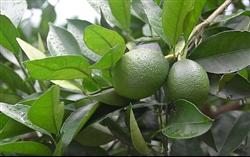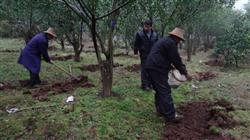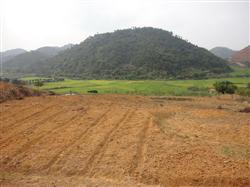How to manage oranges in June?

How to manage oranges in June? Please introduce the citrus in June can refer to the following methods for management: (1) continue to protect the fruit in the second physiological drop period (also known as June drop), which begins in mid-late May. The difference between the second physiological drop period and the first physiological drop period is that there is no stalk. For the crown fruit size is not obvious, small fruit is more, in order to reduce fruit drop, to strengthen extra-root topdressing, spray 0.2% urea plus 0.3% potassium dihydrogen phosphate or nutrient liquid fertilizer every 10 days or so, mountain orange orchard plus 0.2% borax spray. Young fruiting trees, strong and prosperous trees prone to fruit drop, wipe summer shoots every 7 to 10 days to protect fruit. In view of the fierce competition for nutrients in the top fruit, which is easy to aggravate the fruit drop, the strong and prosperous trees that have been girdled (peeling 2mm to 3mm) should be checked again before the first ten days of June, and the healing tissue of the ring that healed ahead of time should be wiped off again. (2) Tree management for young trees, coring is carried out when the summer shoot is more than 25cm and 30cm, so as to promote branching and shoot, and expand the crown. For adult fruiting trees, summer shoot emergence and growth should be controlled by fertilizer and water control and sprouting. Aging trees, heavy pruning trees, high grafted trees and other bare branches, with the rise of temperature, strong light, prone to branch burns, should be painted white. The white coating formula is 500 grams of quicklime, 15 grams of sulfur powder, 10 grams of salt and 3-4 kilograms of clear water. Coarse fruit thinning can be carried out after the second physiological fruit drop at the end of June. At this time, most of the wide-skinned citrus fruits are less than 2.5cm in transverse diameter, which is mainly aimed at the plants with many fruits. Before thinning the fruit, make a general judgment on the whole orchard. Starting with the orange trees with too many fruits, the leaves and fruits are thicker and thinner than 15:1. Sparse disease and insect fruit, deformed fruit, mechanically damaged fruit, small fruit and over-dense fruit. During the rainy season, weeds are allowed to grow, dredging ditches and preventing stagnant water. (3) the disease and pest control was hot and humid at this time, the citrus rust wall lice entered the period of rapid proliferation, and the black spot disease first occurred in early June. If the leaf or fruit is under a 10x magnifying glass with 1 to 2 rust wall lice per field of view, or if the back of the spring leaf is first damaged, prevention and control should be started. You can choose 25% 50% phenylbutyltin 1500 × 2000 times solution, or 20% carbosulfan 1500 times solution, etc., plus mancozeb 600,800 times solution to control rust wall lice and black spot disease. Black spot disease was prevented and treated again at the end of June and the first ten days of July. Longicorn beetles can capture adults, remove eggs and larvae, and when larvae cannot be hooked, cotton dipped in 80% dichlorvos EC or 40% dimethoate EC is used to plug the hole and seal the slime to achieve the purpose of fumigation. In the first and second generation incubation period, 99% engine oil emulsion and 1000 times of buprofezin (buprofezin) were selected for scale control. Click to get more citrus planting techniques click to get more fruit planting techniques
- Prev

How to manage oranges in July?
How to manage oranges in July? Please introduce that citrus in July can be managed with reference to the following methods: (1) Fertilizer and water management is easy to meet high temperature and summer drought in July, and the chance of rainstorm is also significantly increased. Therefore, all localities should pay special attention to the weather forecast of local meteorological stations and use straw in tree plates in case of drought.
- Next

What kind of soil is suitable for growing blueberries?
What kind of soil is suitable for growing blueberries? Please guide the most ideal soil type for blueberry cultivation is acid sandy loam, sandy soil or peat soil with loose, well-aerated, moist and high organic matter content. Blueberries are cultivated on calcareous soil, clayey soil, dry soil and soil with low organic matter content.
Related
- Moge, come on! The staff of the peasant association in the producing area of cantaloupe were frightened when the crowd gathered.
- Causes and Solutions of low Fruit setting rate of Apple
- Symptoms and control measures of passion fruit virus disease
- Fruit growing lesson: how do apple orchards keep high yields?
- Can you build orchards in the mountains? What are the pros and cons?
- How to manage the coloring period of Crisson grape?
- This paper introduces the processing technology of two kinds of fig products.
- How much is a month for retired teachers in rural areas by 2020?
- How can strawberry planting increase sugar content? We should pay attention to management in many aspects.
- What are the cultivation techniques on how to improve the yield of golden fruit?

